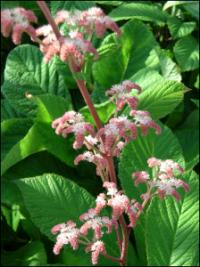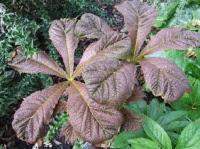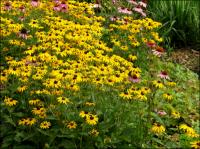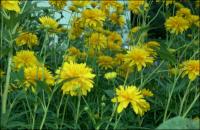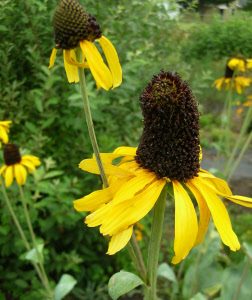Perennials & Biennials
Showing 377–384 of 485 results
-
Rheum palmatum var. tanguticum Ornamental rhubarb Z 4-8
Gigantic, jagged-edge, bronze-tinted turning green foliage with pink plumes reaching skyward atop tall stalks in early summer.
OUT OF STOCK
Gigantic, jagged-edge, bronze-tinted turning green foliage with pink plumes reaching skyward atop tall stalks in early summer.
Size: 8' x 6'
Care: Sun to part shade, moist well-drained fertile soil, mulch in spring
Native: valleys of Gansu, Qinghai, Shaanxi, Xizang, ChinaRhubarb carried from its native China to central Asia and then Europe by caravans more than 2000 years ago. Both Greek physician Dioscoride (40-90) s and Roman Pliny (23-79) mentioned the plant during the 1st century. In 1300’s Marco Polo explained that merchants of China do not take their beasts of burden into the mountains where rhubarb grows because “if eaten (causes) the hoofs of the animal to drop off.” This variety 1st described in 1874.
-
Rodgersia aesculofolia Finger-leaf rodgersia Z 5-7
Showy, fragrant, pink-tinged, ivory flowers along stems rising up to 2’ over basal foliage. Come for the flowers and stay for the foliage - 12” wide bronze-tinted, crinkled, double-tooth edged, palmate shaped of seven leaflets radiate like spokes of a wheel.
Showy, fragrant, pink-tinged, ivory flowers along stems rising up to 2’ over basal foliage. Come for the flowers and stay for the foliage – 12” wide bronze-tinted, crinkled, double-tooth edged, palmate shaped of seven leaflets radiate like spokes of a wheel.
Size: 3-5’ x3-5’
Care: sun to part shade in moist well-drained to wet soil
Native: northern ChinaFirst collected in Sichuan province, China by Siberian Grigorii Potanin (1835-1920) in 1884. Trudy Imp. S.-Peterburgsk. Bot. Sada vol 13 p. 96 (1893). For his political activity as a Siberian separatist Potanin spent years in Russian prison. An accomplished geographer and naturalist he explored much of Kazakhstan and Mongolia and parts of China. In 1879-1880 he explored northern Mongolia collecting many plants and animal specimens.
-
Rodgersia pinnata Rodger’s flower Z 5-8
Ground-hugging mound of bold leaves arranged opposite one another along the stem (pinnate, this is why it’s called pinnata) appear to be arranged in the shape of a hand (palmate) because the leaves are so large it’s hard to see the difference. To translate, the leaves are a sight to behold featuring their big size, crinkled texture, and, dark veins. This blooms on a stalk about a foot taller than the leaves in July-August pink, sometimes white.
Ground-hugging mound of bold leaves arranged opposite one another along the stem (pinnate, this is why it’s called pinnata) appear to be arranged in the shape of a hand (palmate) because the leaves are so large it’s hard to see the difference. To translate, the leaves are a sight to behold featuring their big size, crinkled texture, and, dark veins. This blooms on a stalk about a foot taller than the leaves in July-August pink, sometimes white.
Size: 3' x 30" and slowly spreading by rhizomes
Care: shade in moist soil
Native: China
Wildlife Value: deer resistant.
Awards: England’s Royal Horticultural Society Award of Merit & Elisabeth Carey Miller Botanical Garden Great Plant PicksRodgersia named for American Admiral John Rodgers (1812-1882) who led an expedition in the Pacific in 1852 during which the 1st species of this genus was discovered. This species introduced from its native China by Ernest “Chinese” Wilson (1876-1930) by 1910.
-
Rodgersia podophylla Bronze-leaf rodgersia In China: gui deng qing Z 5-8
Blooming, creamy white panicles in summer, atop five leaflets, shield-shaped, jagged incisions at the ends forming a palmate, open hand shape and a tint of bronze coloring.
Blooming, creamy white panicles in summer, atop five leaflets, shield-shaped, jagged incisions at the ends forming a palmate, open hand shape and a tint of bronze coloring.
Size: 3-5’ x 3-4’ and slowly spreading by rhizomes.
Care: part shade in moist to moist well-drained acidic soil
Native: woodland & stream edges in Japan, China & Korea
Awards: Elisabeth Carey Miller Botanic Garden, Great Plant Pick Award.Rodgersia named for American Admiral John Rodgers (1812-1882) who led an expedition in the Pacific in 1852 during which this plant was collected. 1st mentioned in literature 1858. Named by Harvard botanist Asa Gray. Species name from the Greek for foot (podos) and leaf (phyllon).
-
Rudbeckia fulgida Black eyed susan Z 4-9
The classic Black-eyed susan, 2-3" wide yellow daisies with a dark center from July-October
The classic Black-eyed susan, 2-3″ wide yellow daisies with a dark center from July – October
Size: 30" x 18"
Care: full sun to part shade in moist well-drained to well-drained soil
Native: East and Southeastern U.S.
Wildlife Value: A great number of bees, flies and beetles collect pollen or drink nectar from this RudbeckiaCherokee ate the stems and leaves and used this species to remedy earaches, sores, flux, venereal disease, snakebites, dropsy, and swelling. Iroquois healed the heart and rid children of worms with this, Potawatomi make a brown dye with this. This species fulgida was introduced to England in 1760 and named in William Aition’s Hortus Kewensis, V. 3 p. 251 (1789).
-
Rudbeckia laciniata var. hortensia Golden Glow Z 3-9
Imposing double daisies with multiple petals bloom atop a 6 or 7 foot erect stem as thick as a small tree trunk reign over neighboring flowers like a king. “Rich, yellow double flowers borne in autumn, excellent for cutting, “Sanders 1913. Blooms July-August.
Imposing double daisies with multiple petals bloom atop a 6 or 7 foot erect stem as thick as a small tree trunk reign over neighboring flowers like a king. “Rich, yellow double flowers borne in autumn, excellent for cutting, “Sanders 1913. Blooms July-August.
Size: 5-7' x 12" and spreading
Care: sun in moist well-drained to well drained soil, drought tolerant
Wildlife Value: Immune to Walnut toxinsSerendipitous discovery in a group of seedlings in 1894. Said to be “the most popular hardy perennial introduced during the last 25 years,” April, 1905, The Garden magazine. Recommended by Gertrude Jekyll in 1908. Beth in New Mexico advised that her alpaca named Ricardo finds them delicious.
-
Rudbeckia maxima Great coneflower Z 4-9
Magnificent wildflower with huge paddle-shaped leaves of blue-grey-green and tall stalks of finch-gold petals
Magnificent wildflower with huge paddle-shaped leaves of blue-grey-green and tall stalks of finch-gold petals encircling central cones 4-5″ tall.
Size: 5-6' x 2'
Care: Sun in moist to moist well-drained soil
Native: OK, AK, TX & LA
Wildlife Value: Nectar source for larvae of painted Lady butterfly & for large Wood nymph butterfly.Rudbeckia was named by Linnaeus for his University of Upsala professor, Olaf Rudbeck. Rudbeck made the surprising claim “that the Paradise of Scripture was situated somewhere in Sweden.” C.F. Leyel. This species collected by Englishman Thomas Nuttall (1786-1859) in Oklahoma Territory near the Red River in 1816. Nuttall searched much of the No. American continent from New England west to Oregon, the South, Midwest, the Plains, S.E., California & Hawaii, finding thousands of new plants.
-
Rudbeckia subtomentosa ‘Henry Eilers’ Z 4-8
These Rudbeckias tower above basal leaves on rigid, branching stems forming clumps of sun yellow petaled flowers surrounding a raised, brown dome of disc flowers. But instead of flat petals, the petals are rolled into narrow tubes, looking like many spokes of a wheel blooming from mid-summer into fall.
OUT OF STOCK
These Rudbeckias tower above basal leaves on rigid, branching stems forming clumps of sun yellow petaled flowers surrounding a raised, brown dome of disc flowers. But instead of flat petals, the petals are rolled into narrow tubes, looking like many spokes of a wheel blooming from mid-summer into fall.
Size: 3-5’ x 1-2’
Care: sun in moist well-drained soil
Wildlife Value: attracts butterflies, deer resistantHenry Eilers discovered this cultivar while scouting a southern Illinois prairie. Here is his story.
Henry Eilers, born in 1934, long-time nurseryman, had introduced selections of different ornamental plants that he found growing at his nursery. But Rudbeckia subtomentosa ‘Henry Eilers’ is different. Henry worked tirelessly for decades to preserve Illinois plants and their diversity. In the early 1980’s while scouting a prairie remnant near Witt in Montgomery County IL he spied a small clump of uncommon Black-eyed susan. Instead of the usual broad, flat petals, this one has narrow, quilled petals. He dug it and replanted it at his nursery where it grew on. It still grows in his wildflower garden. He decided to name it Rudbeckia ‘Montgomery County.’ In the 1990’s Henry took it and other native wildflowers to a native plant sale at the Shaw Arboretum, Missouri Botanic Garden. He and another nurseryman, Larry Lowman exchanged a few plants, one being this Rudbeckia. Several years later he found it for sale in the Plant Delight’s Nursery catalog, renamed Rudbeckia ‘Henry Eilers.’ Over time the plant appeared in gardening magazines and mail order catalogs. It now grows in the entrance planting at the National Botanic Garden in Washington, at the Missouri Botanic Garden and the Brooklyn Botanic Garden. A nurseryman from the Czech Republic told Henry he had been growing it!



